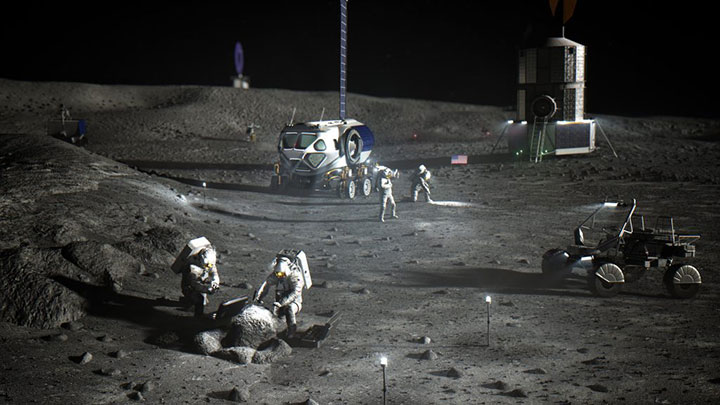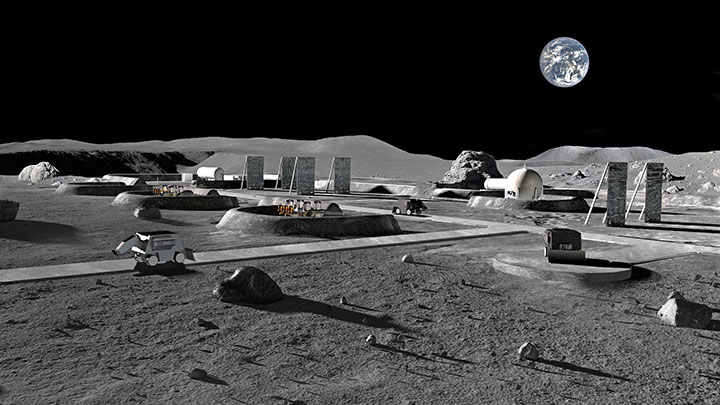 An artist’s concept of NASA astronauts working on the lunar South Pole. (Source: NASA)
An artist’s concept of NASA astronauts working on the lunar South Pole. (Source: NASA)
32 nations are working together under the Artemis Accords to return humans to the Moon in 2025, 53 years after the final Apollo mission left the lunar surface. And they’re not alone. More than a hundred other lunar missions are scheduled in the next decade—most planning to enter lunar orbit or put a rover on the lunar surface. But operating in cislunar space isn’t simple or easy, and any type of lunar mission depends on a vast amount of infrastructure.
The operational challenges include establishing regular communication and navigation capabilities, handling the massive payloads required to take the necessary infrastructure to the surface of the moon and building machinery capable of surviving the lunar night. As Greg Johnson, Business Director at Swedish Space Corporation (SSC) put it, “There are two things you need on the surface of the moon: communications and power.”
With NASA’s competitive commercial contracts, many companies are entering cislunar space and confronting these problems head-on—slowly but surely turning the Moon into a sustainable economy.
Communications and Navigation
Swedish Space Corporation manages a large ground network, including five ground stations that form a part of NASA’s Near Space Network. The ground network has been used to support a variety of missions, including the Lunar Reconnaissance Orbiter, which has been orbiting the moon since 2009.
SSC is one of the few companies tasked with managing communications in cislunar space. It can take hours of ranging every day to know exactly where a spacecraft is, which is why, according to Johnson, “services are needed, often daily, to enable Trajectory Correction Maneuvers to keep the spacecraft on course.” To tackle this complexity, SSC is planning to grow its network significantly, both in terms of aperture size (20m) and number of antennas, to properly support the increasing number of lunar missions.
“Many companies can support LEO and MEO, but once a spacecraft goes past GEO into cislunar and lunar, size really does matter,” Johnson says. He pointed out that this expansion of ground segment capabilities would support future commercial missions beyond the moon. SSC already has its sights set on potential Mars missions and the company plans to be the commercial alternative to the NASA Deep Space Network.
Navigating on the surface of the moon can get tricky fast, according to Al Tadros, CTO of Redwire, a space infrastructure technology company. “On the lunar surface, there are no street signs or maps, nor is there any GPS. … Apollo astronauts had a hard time even sensing distances, just looking out over craters and not being able to tell whether it’s 100 meters or a kilometer away.”
Redwire will be supplying core avionics to Firefly Aerospace’s Blue Ghost Mission 1, which will land on the moon in 2024 carrying a NASA payload. This payload will support terrain navigation with a weak-signal GNSS radio receiver and GNSS antenna in an attempt to use Earth-orbiting GNSS on the lunar surface.
Power through the Lunar Night
When planning to stay on the moon long term, “heat to survive the lunar night is the key problem to solve,” says Johnson. The lack of atmosphere on the moon, combined with a 14-day night means machinery needs to be designed to store enough power to survive the night. Presently, most lunar missions land rovers as close to dawn as possible, collect data for the 14-day period of light and then lose communications with the onset of night.
Building a sustained presence requires a power source to keep the equipment warm through the night. NASA recently awarded a contract to Astrobotic, Honeybee and Lockheed Martin for Vertical Solar Array Technology (VSAT), which will be deployed near the South Pole of the moon in an attempt to maintain power throughout the lunar night.
Redwire has also developed ROSA, a roll-out solar array that will make up part of the power and propulsion element of the Artemis Lunar Gateway, the planned space station orbiting the moon. But producing adequate power is only the first half of the problem, and Tadros emphasized the importance of building physical infrastructure on the lunar surface. “Part of the infrastructure has to be landing pads and roads that provide solid surfaces to move around,” he said.
 An artist’s rendition of physical infrastructure on the moon to support a sustained presence. (Source: Redwire)
An artist’s rendition of physical infrastructure on the moon to support a sustained presence. (Source: Redwire)
To build that physical infrastructure, Redwire is experimenting with sintering, a heat treatment process that uses a radiofrequency transmitter (similar to a microwave oven), to melt lunar regolith before allowing it to cool and solidify into a solid surface. This is an example of the development of in-situ resource utilization, which requires using the moon’s existing resources to produce water, fuel and other supplies, and also excavate and construct structures.
Looking Forward to Sustained Commercial Activity
Returning to the moon is only the first obstacle; traveling between the Earth and moon frequently requires a sustainable lunar economy, and NASA is leading the push for developing technology in cislunar space. “NASA’s investments go into developing and burning down the risks of a lot of technologies that can be used in other areas,” Tadros said.
While the current cost of reaching the lunar surface remains exorbitant, Tadros predicts regular commercial activity. “The cost of accessing the lunar surface is going to have to drop. … While it might take a decade or more to get to that point, I expect the commercial activity.”
This new space is becoming competitive quickly. If successful, Astrobotic’s Peregrine lander, scheduled for December 2023, will make it the first commercial company to land on the moon. Programs like SpaceX’s Starship could instigate this increase in activity and make the lunar surface commercially available for many more companies.
Explore More:
Podcast: Building in Sustainability, Cislunar Infrastructure and Furthering Exploration
Podcast: Artemis, CAPSTONE and the Challenge of Cislunar Navigation
Government Space Spending Priorities: Earth vs. Exploration
Why is the FBI Going to the Moon?
